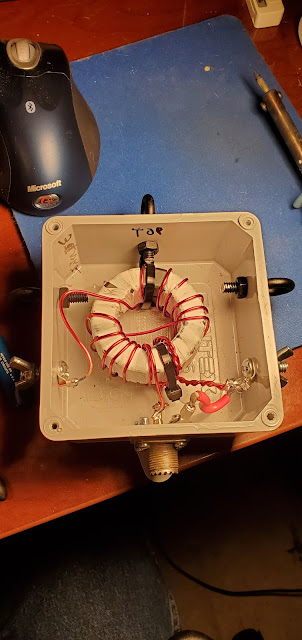End-Fed Half-Wave Antenna for HF
It's been a few months since I last posted anything here on the blog but I've kept busy. The COVID virus has me working from home every other week. Since everyone has settled into the 'battle rhythm' of remote work, I stay surprisingly engaged.
I have focused on VHF+ operation since around April 2020 and have produced several projects in pursuit of improving my stations--both mobile and home. When my 20-meter half-square and 40-meter Double Bazooka antennas came down during a summer storm, I left them down for quite a while. The CQWW DX-CW contest was coming up and I have set a goal to get my Mixed DXCC done. At 64 countries confirmed, I decided to get back on the air.
A few years ago, I built a small 4:1 BALUN to use with my QRP rigs. This antenna accepted a half-wave section of wire and would work only on the band for which the wire was cut. It worked very well but it was only meant for temporary installation and had little to no waterproofing. To change bands, I had to change the radiating element.
After reading up for months, I chose to construct another End-Fed Half-Wave antenna but make it multi-band capable this time. What I learned is that building a 49:1 UNUN (Unbalanced to Unbalanced) transformer would tame the seriously high impedances exhibited by the radiating element of this type of antenna. The UNUN would allow use on multiple bands and I had enough room in the yard to fit a 136-foot 80-meter wire.
I followed the excellent directions given in a writeup by Steve Dick-K1RF. He goes into the theory of how the EFHW works along with several different types of EFHW. My requirements led me to construct a system with a 49:1 UNUN because, according to Steve, With a 49:1 or 64:UNUN, no tuning is required and no antenna tuner is required (or perhaps a "touch up" tuner with up to 3:1 VSWR capability that many modern rigs have built-in).
After construction, I added the 80-meter wire which goes up 10-feet to the edge of the roof and then slopes upward into the top of a 60-foot pine tree. I was able to tune the antenna up on the following bands with the following 'raw' SWR values listed below. Since I am a CW operator, I will probably add a small loading coil about 78-inches up the main radiator which should bring the resonant frequency down on the low bands while not affecting the higher bands. As is, the use of my rig's tuner allows for operating.
80-meters 4.0:1
40-meters 2.5:1
30-meters 2.8:1
20-meters 2.8:1
15-meters 2.8:1
12-meters 2.5:1
10-meters 3.0:1
Here are some pictures of the finished product:






Comments
Post a Comment